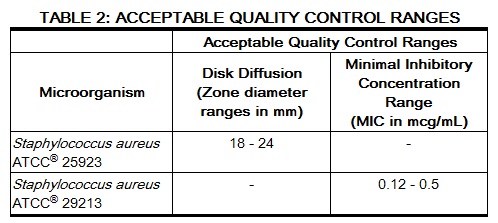Cloxacillin Sodium microbiology: Difference between revisions
No edit summary |
No edit summary |
||
| Line 31: | Line 31: | ||
*'''Quality Control''' | *'''Quality Control''' | ||
Standardized susceptibility test procedures require the use of laboratory control microorganisms.1,2,3 The 1 mcg oxacillin disk and the standard oxacillin powder should provide respectively the following zone diameters and MIC values in these laboratory test quality control strains: | Standardized susceptibility test procedures require the use of laboratory control microorganisms.1,2,3 The 1 mcg oxacillin disk and the standard oxacillin powder should provide respectively the following zone diameters and MIC values in these laboratory test quality control strains:<ref name="dailymed.nlm.nih.gov">{{Cite web | last = | first = | title = DICLOXACILLIN SODIUM CAPSULE [SANDOZ INC] | url = http://dailymed.nlm.nih.gov/dailymed/lookup.cfm?setid=65c3e99b-ec77-416c-ad70-596d6f0a9c31#nlm34089-3 | publisher = | date = | accessdate}}</ref> | ||
[[File:Quality control cloxacillin sodium.jpg]] | |||
==References== | ==References== | ||
Revision as of 18:40, 2 January 2014
Editor-In-Chief: C. Michael Gibson, M.S., M.D. [1]; Associate Editor(s)-in-Chief: Mohamed Moubarak, M.D. [2]
Microbiology
Penicillinase-resistant penicillins exert a bactericidal action against penicillin-susceptible microorganisms during the state of active multiplication. All penicillins inhibit the biosynthesis of the bacterial cell wall.
Dicloxacillin sodium has been shown to be active against most strains of the following microorganisms, both in vitro and in clinical infections as described in the INDICATIONS AND USAGE section.
Aerobic Gram-Positive Microorganisms
Staphylococcus spp. (penicillinase producing)
Susceptibility Testing
- Diffusion Techniques
Quantitative methods that require measurement of zone diameters provide reproducible estimates of the susceptibility of bacteria to antimicrobial compounds. One such standardized procedure1,2 that has been recommended for use with disks to test the susceptibility of microorganisms to dicloxacillin, uses the 1 mcg oxacillin disk. Interpretation involves correlation of the diameter obtained in the disk test with the minimum inhibitory concentration (MIC) for dicloxacillin.
Reports from the laboratory providing results of the standard single-disk susceptibility test with a 1 mcg oxacillin disk should be interpreted according to the criteria provided in Table 1.
- Dilution Techniques
Quantitative methods that are used to determine minimum inhibitory concentrations (MICs) provide reproducible estimates of the susceptibility of bacteria to antimicrobial compounds. One such standardized procedure1,3 uses a standardized dilution method (broth or agar) or equivalent with oxacillin powder. The MIC values obtained should be interpreted according to the criteria provided in Table 1.
A report of “Susceptible” (S) indicates that the pathogen is likely to be inhibited by usually achievable concentrations of the antimicrobial compound in the blood. A report of “Intermediate” (I) indicates that the result should be considered equivocal, and, if the microorganism is not fully susceptible to alternative, clinically feasible drugs, the test should be repeated. This category implies possible clinical applicability in body sites where the drug is physiologically concentrated or in situations where high dosage of drug can be used. This category also provides a buffer zone that prevents small uncontrolled technical factors from causing major discrepancies in interpretation. A report of “Resistant” (R) indicates that usually achievable concentrations of the antimicrobial compound in the blood are unlikely to be inhibitory and that other therapy should be selected.
Measurement of MIC and achieved antimicrobial compound concentrations may be appropriate to guide therapy in some infections. (See CLINICAL PHARMACOLOGY section for further information on drug concentrations achieved in infected body sites and other pharmacokinetic properties of this antimicrobial drug product.)
- Quality Control
Standardized susceptibility test procedures require the use of laboratory control microorganisms.1,2,3 The 1 mcg oxacillin disk and the standard oxacillin powder should provide respectively the following zone diameters and MIC values in these laboratory test quality control strains:[1]
References
- ↑ "DICLOXACILLIN SODIUM CAPSULE [SANDOZ INC]". Text " accessdate" ignored (help)
Adapted from the FDA Package Insert.

